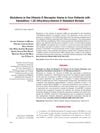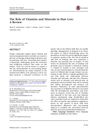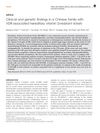TLDR Two siblings with a genetic mutation had a form of rickets that doesn't respond to vitamin D.
In 2017, a study was conducted on two Iranian siblings suffering from Hereditary Vitamin D Resistant Rickets (HVDRR), a rare disease characterized by rickets, alopecia, and growth retardation. The siblings, followed for 27 years, exhibited symptoms like rickets, growth retardation, muscle weakness, hypocalcemia, and alopecia totalis since early childhood. Genetic testing revealed a mutation in the VDR gene, causing their resistance to vitamin D. Despite treatment with high doses of calcium and active vitamin D, no significant improvement was observed in their condition. The study concluded that genetic testing is crucial for diagnosing HVDRR and that normal hair growth depends on the interaction of Vitamin D Receptor (VDR) with a nuclear transcription factor named hairless protein (Hr). The male sibling had severe bone loss, while the female sibling had normal Bone Mineral Density (BMD), despite having a more severe form of the disease.
107 citations
,
March 2014 in “BoneKEy Reports” Mutations in the vitamin D receptor cause hereditary vitamin D-resistant rickets, leading to poor bone health and requiring high calcium doses for treatment.
151 citations
,
June 2010 in “Endocrinology and metabolism clinics of North America” Two rare genetic diseases cause severe rickets in children due to defects in vitamin D metabolism.
22 citations
,
April 2010 in “Journal of Cellular Biochemistry” Certain mutations in the hairless protein disrupt its ability to regulate the hair cycle.
50 citations
,
September 2009 in “Molecular Genetics and Metabolism” A new gene mutation causes vitamin D resistance and rickets, treatable with calcium therapy.
 24 citations
,
November 2008 in “Arquivos Brasileiros de Endocrinologia & Metabologia”
24 citations
,
November 2008 in “Arquivos Brasileiros de Endocrinologia & Metabologia” Four patients with a type of rickets and hair loss had different mutations in their vitamin D receptor gene, causing it to not work properly.
47 citations
,
October 1989 in “European Journal of Pediatrics” Two siblings stayed rickets-free for 14 years after stopping treatment.
11 citations
,
January 2018 in “DOAJ (DOAJ: Directory of Open Access Journals)” A 4-year-old boy with a rare type of rickets and hair loss improved in bone health but not hair growth after vitamin D and calcium treatment.
 134 citations
,
December 2018 in “Dermatology and Therapy”
134 citations
,
December 2018 in “Dermatology and Therapy” Some vitamins and minerals like vitamin D and iron can help with certain types of hair loss, but more research is needed for others.
12 citations
,
September 2017 in “JDR Clinical & Translational Research” Early detection of specific VDR mutations is crucial for effective treatment and better dental outcomes in children with hereditary vitamin D–resistant rickets.
 7 citations
,
June 2016 in “Bone Research”
7 citations
,
June 2016 in “Bone Research” A Chinese family had a child with a specific gene mutation causing vitamin D-resistant rickets, but the child improved with calcium and low-dose calcitriol.
 March 2023 in “International journal of trichology”
March 2023 in “International journal of trichology” Six genetic conditions are often linked to complete scalp hair loss in children.



